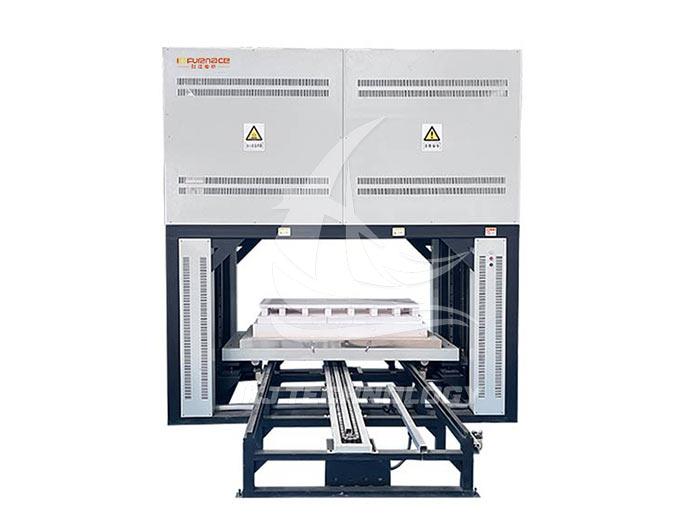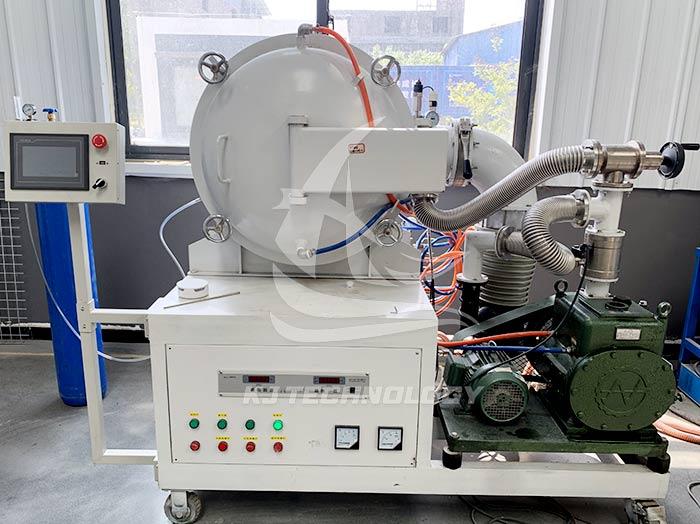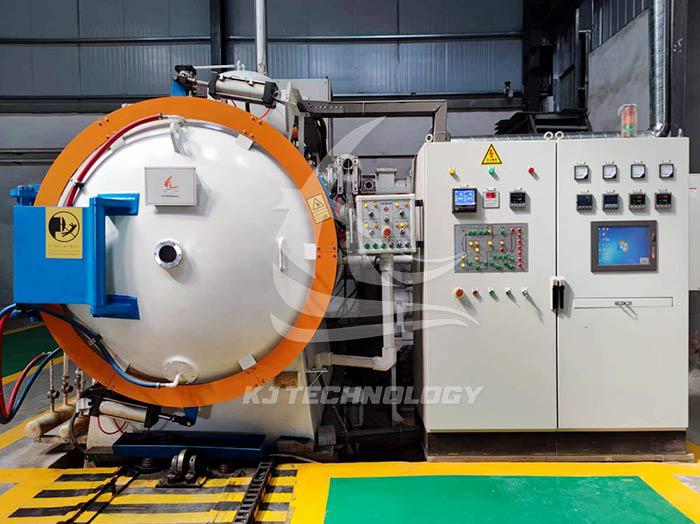Large scale furnace vacuum heat treatment furnace
 09-29-2025 Author: KJ technology
09-29-2025 Author: KJ technology
Large scale furnace vacuum heat treatment furnace is a device designed specifically for processing large or batch workpieces, with characteristics such as high vacuum degree, temperature uniformity, automatic control, and strict sealing. It is widely used in aerospace, automotive manufacturing, mold processing, and other fields.
1. Core Features
High vacuum degree
A large-sized furnace vacuum heat treatment furnace uses a combination of mechanical pumps (such as rotary vane pumps) and molecular pumps (or diffusion pumps) to reduce the pressure inside the furnace to an extremely low level (such as 10 ⁻²~10 ⁻⁴ Pa), far below atmospheric pressure (10 ⁵ Pa).
High vacuum environment can significantly reduce oxygen partial pressure, avoid oxidation, decarburization or carbonization of workpieces at high temperatures, and improve the surface quality of materials (such as improving the surface smoothness of high-speed steel cutting tools after heat treatment).
Temperature uniformity and temperature control accuracy
The furnace adopts multi-layer insulation materials (such as polycrystalline alumina ceramic fiber, insulation cotton) and high-efficiency heating elements (such as molybdenum resistance wire, silicon carbon rod, silicon molybdenum rod), combined with PID intelligent microcomputer programmable control, to achieve temperature uniformity within ± 5 ℃ and temperature control accuracy within ± 1 ℃.
The heating rate can be adjusted (0-20 ℃/min) to meet the heat treatment needs of different materials.
Automation and Intelligence
Equipped with industrial precision 0.2 level intelligent instruments, supporting multi-stage program temperature control, and can pre store multiple process parameters (such as 16 sintering processes), simplifying the operation process.
Integrate over temperature protection, disconnection warning and other functions to ensure the safe operation of the equipment.
Strict sealing and water cooling device
The furnace body adopts a double-layer water-cooled sealing structure, and the furnace door is sealed by adding a silicone ring to the head for compression. The cold vacuum degree can reach 10 ⁻ Pa.
Key components such as furnace shells, furnace covers, and electric heating elements are equipped with water cooling devices to prevent thermal deformation or damage to sealing materials due to overheating.
2. Typical applications
Aerospace field
After vacuum solution treatment at 1150 ℃, the grain size of nickel based high-temperature alloy blades is refined and the high-temperature strength is improved.
Titanium alloy forgings are vacuum annealed at 800 ℃ to eliminate forging stress and avoid surface oxidation, and are used for aircraft landing gear.
automobile manufacturing
Gear vacuum carburizing: carburizing at 930 ℃ under low vacuum of 500 Pa, with high surface hardness and improved wear resistance compared to traditional gas carburizing.
Vacuum quenching of mold steel: H13 steel undergoes high-pressure gas cooling after austenitization at 1020 ℃, resulting in higher hardness and extended thermal fatigue life.
Mold processing and microcrystallization
Electronic ceramics and high-temperature structural ceramics sintered for higher density, used for high-power LED packaging.
Powder metallurgy and sintering of nanomaterials to optimize material properties.
medical device
After vacuum annealing at 1050 ℃, 316L stainless steel surgical instruments have lower surface roughness and do not require subsequent polishing.
Cobalt chromium alloy joint prostheses undergo vacuum solution treatment at 1200 ℃ to eliminate casting defects and enhance biocompatibility.
3. Technical advantages
Non oxidizing heating
In a vacuum environment (<10 ⁻ ² Pa), the oxygen partial pressure is extremely low, and an oxide film cannot form on the metal surface, reducing material loss.
Inhibit decarbonization
When carbon steel is heated in air, the surface carbon reacts with oxygen to produce CO ₂, resulting in a decrease in hardness; The thickness of the decarburization layer under vacuum environment can be controlled within 0.01mm.
Degassing effect
At high temperatures, gas impurities such as hydrogen, oxygen, and nitrogen inside the material will diffuse to the surface and be pumped away by a vacuum pump, reducing defects such as pores and cracks.
Remove adsorbates
Vacuum environment can remove moisture, oil stains, etc. adsorbed on the surface of materials, improving the quality of subsequent coatings or welding.
4. Development Trends
Higher vacuum degree
Develop ultra-high vacuum furnaces exceeding 10 ⁻⁴ Pa to meet the cleanliness requirements of semiconductor materials such as silicon wafers.
Higher temperature
Develop graphite heating elements and ceramic insulation materials to achieve high temperature treatment above 2500 ℃ (such as silicon carbide fiber preparation).
AI control
Optimizing the heating curve through machine learning to achieve a dynamic balance between material properties and energy consumption.
composite process
Integrating multiple processes such as vacuum brazing, carburizing, and quenching to shorten the production cycle (such as integrated manufacturing of aircraft engine shafts).
Energy-saving technology
By adopting a waste heat recovery system, the heat from the cooling gas is used to preheat the workpiece, reducing energy consumption by 20%.
modular design
Develop detachable vacuum chambers to reduce maintenance costs (such as quick replacement of graphite heating elements).








